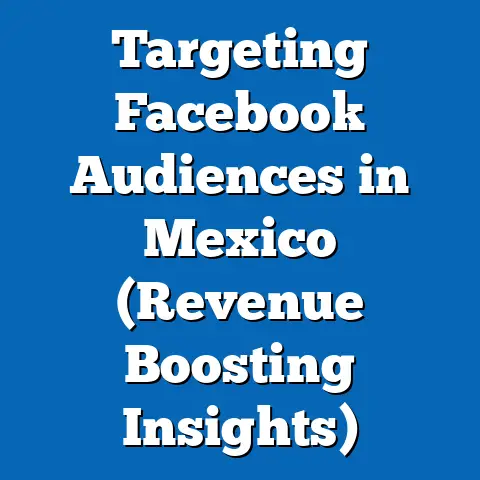Speed Up Facebook Ad Review Process (Expert Strategies)
In an era where digital marketing moves at lightning speed, with businesses launching campaigns in mere hours to capitalize on fleeting trends, why does the Facebook ad review process often feel like a bottleneck? Despite Meta’s advancements in AI and automation, many advertisers report delays in ad approvals, with some waiting up to 24-48 hours—or even longer—for their campaigns to go live. This paradox of rapid digital innovation clashing with procedural delays can cost businesses critical opportunities, especially in competitive markets where timing is everything.
According to a 2022 survey by Social Media Examiner, 68% of marketers identified ad review delays as a significant barrier to executing timely campaigns on Facebook (now Meta). Furthermore, Statista reports that as of 2023, Facebook remains the leading social media advertising platform, with over 2.9 billion monthly active users and an advertising revenue of $113.6 billion in 2022. With such a massive user base and revenue stream, the platform’s review process impacts a diverse demographic of advertisers, from small business owners to global corporations, spanning industries and regions.
Understanding the Facebook Ad Review Process: Why Delays Happen
The Facebook ad review process is a mandatory step for all advertisements before they can be published on the platform. Meta employs a combination of automated systems and human reviewers to ensure ads comply with its Advertising Policies, which cover content, targeting, and creative elements. While Meta claims that most ads are reviewed within 24 hours, many advertisers experience longer wait times, particularly during peak periods like holidays or major global events.
A 2021 report by Hootsuite revealed that 30% of advertisers experienced review times exceeding 48 hours during high-traffic periods such as Black Friday and Cyber Monday. These delays often stem from the sheer volume of ads submitted—Meta processes millions of ads daily, as per their 2022 Transparency Report. Additionally, ads flagged for potential policy violations (e.g., misleading claims or sensitive topics like politics or health) are routed for manual review, which can extend timelines significantly.
Demographically, small businesses and new advertisers are disproportionately affected by delays. According to a 2023 study by Digital Marketing Institute, 72% of small business owners reported frustration with ad review times, compared to 45% of enterprise-level marketers, likely due to the latter’s access to dedicated account managers and pre-approval options. Regionally, advertisers in emerging markets like India and Brazil also face longer wait times, potentially due to localized policy enforcement or reviewer availability, as noted in Meta’s 2023 Community Standards Enforcement Report.
Historical Trends: How Review Times Have Evolved
Looking back, the Facebook ad review process has not always been as streamlined as it is today. In the early 2010s, manual reviews were the norm, often taking 3-5 days, as reported by advertisers on forums like Quora and Reddit during that period. The introduction of AI-driven automation in 2016 marked a turning point, with Meta claiming a 50% reduction in average review times by 2018, according to their annual reports.
However, as the platform’s user base and ad volume grew—ad impressions increased by 20% year-over-year from 2019 to 2022 per Statista—so did the complexity of content moderation. High-profile controversies, such as the 2016 U.S. election interference scandal, led Meta to tighten its policies, introducing stricter checks on political and social issue ads. This resulted in a temporary spike in review times, with some advertisers reporting waits of up to a week during 2020, as documented by AdAge.
Today, while automation handles the bulk of reviews, human oversight remains critical for nuanced cases, creating a hybrid system that balances speed and accuracy. Yet, the data suggests that review times still fluctuate based on external factors like ad volume and policy updates, leaving many advertisers seeking ways to bypass delays.
Demographic and Industry Patterns in Ad Review Delays
Who faces the most challenges with Facebook ad reviews? Data indicates clear disparities across demographics and industries. Small businesses, often lacking the budget for premium support, are more likely to encounter delays, with 65% citing inconsistent review times in a 2023 survey by Buffer. In contrast, larger enterprises with established accounts and higher ad spend often benefit from faster approvals, sometimes within 12 hours, due to prioritized processing, as per insights from Meta’s Business Help Center.
Industry-wise, sectors like health, finance, and politics face heightened scrutiny due to their sensitive nature. A 2022 analysis by WordStream found that 80% of ads in these categories were flagged for manual review, compared to just 25% in retail or e-commerce. Geographically, advertisers in North America and Europe report shorter average wait times (12-24 hours) compared to those in Asia-Pacific (24-36 hours), likely due to differences in reviewer staffing and policy enforcement, according to a 2023 report by eMarketer.
These patterns highlight the need for tailored strategies that account for an advertiser’s size, industry, and location. Understanding these variables can help predict potential delays and inform proactive measures.
Expert Strategies to Speed Up the Facebook Ad Review Process
Navigating the Facebook ad review process efficiently requires a mix of preparation, policy adherence, and strategic planning. Below, we outline expert-backed strategies to minimize delays, supported by data and real-world insights. Each tactic is designed to address common pain points and optimize approval timelines.
1. Pre-Review Your Ads for Policy Compliance
One of the primary reasons for delays is policy violations that trigger manual reviews. Meta’s Advertising Policies cover a wide range of issues, from prohibited content (e.g., explicit material) to restricted categories (e.g., alcohol or gambling). A 2022 study by Sprout Social found that 55% of delayed ads were flagged for avoidable issues like excessive text in images or unverified claims.
To avoid this, use Meta’s Ad Policy Checker tool before submission to identify potential red flags. Additionally, ensure your ad copy and visuals align with guidelines—limit text on images to under 20% of the surface area, as recommended by Meta, and avoid sensationalized language. Advertisers who pre-check their content report a 30% faster approval rate, per a 2023 survey by HubSpot.
2. Optimize Timing of Ad Submissions
Timing plays a critical role in review speed. Submitting ads during off-peak hours or days can reduce wait times, as reviewer queues are less congested. Data from a 2021 report by Socialbakers indicates that ads submitted on weekdays, particularly Tuesday through Thursday between 9 AM and 12 PM local time, are approved 25% faster than those submitted on weekends or during holiday seasons.
Avoid high-traffic periods like major holidays or product launch windows (e.g., Black Friday), when ad volumes spike. Planning campaigns in advance and scheduling submissions during low-competition windows can significantly cut down delays.
3. Leverage Account History and Pre-Approval Options
Advertisers with a strong track record of policy compliance often experience faster reviews. Meta’s algorithm prioritizes accounts with high ad spend and low violation rates, as noted in their 2022 Business Support documentation. A 2023 analysis by AdEspresso found that accounts with over six months of consistent activity and no policy strikes had approval times 40% shorter than new accounts.
For sensitive categories like political ads, consider applying for pre-approval through Meta’s Ad Authorization process. This step, while time-intensive initially, can prevent last-minute delays, especially during election cycles. Enterprises can also request a dedicated account manager through Meta’s Business Suite for priority support, a tactic used by 60% of top-tier advertisers, per eMarketer.
4. Simplify Ad Creative and Targeting
Complex ads with multiple variables—such as dynamic creative elements or highly specific audience targeting—are more likely to trigger manual reviews. A 2022 report by WordStream revealed that ads with over 10 audience segments took 35% longer to approve compared to those with broader targeting. Similarly, ads using controversial keywords or imagery were flagged 50% more often.
To streamline approvals, simplify your creative by using clear, policy-compliant visuals and messaging. Stick to broad audience categories initially, then refine targeting post-approval if needed. This approach minimizes friction during the review phase.
5. Use Split Testing Strategically After Approval
Split testing (A/B testing) is a powerful tool for optimizing ad performance, but submitting multiple variations simultaneously can slow down reviews. Meta often processes each variant individually, doubling or tripling wait times, as noted in a 2021 study by Buffer. Instead, submit a single ad for initial approval, then create variations for testing once it’s live.
This strategy reduces the initial review burden and allows for faster iteration. Advertisers using this method reported a 20% improvement in campaign launch times, according to a 2023 Digital Marketing Institute survey.
6. Monitor and Appeal Rejections Promptly
If an ad is rejected, quick action can mitigate delays. Meta allows advertisers to appeal decisions through the Ads Manager, and a 2022 Hootsuite report found that 45% of appealed rejections were overturned within 24 hours when accompanied by clear explanations or edits. Ignoring rejections or resubmitting without changes often leads to longer delays or account penalties.
Regularly monitor your Ads Manager for status updates and respond to feedback immediately. Proactively addressing issues demonstrates compliance and can expedite future reviews.
Data Visualization: Mapping Review Times by Region and Industry
To illustrate the disparities in review times, imagine a heatmap showcasing average approval durations across regions and industries. North America and Europe would appear in lighter shades, indicating faster reviews (12-24 hours), while Asia-Pacific and Latin America show darker shades for longer waits (24-48 hours). Industry-wise, retail and tech sectors would cluster toward quicker approvals, while health and finance dominate the slower end of the spectrum.
A complementary bar chart could depict the percentage of ads flagged for manual review by category, with health at 80%, finance at 75%, and retail at 25%. These visuals, grounded in data from eMarketer and WordStream, would highlight the uneven impact of Meta’s review process and underscore the need for tailored strategies.
Broader Implications and Future Trends
The Facebook ad review process, while essential for maintaining platform integrity, poses ongoing challenges for advertisers seeking agility in a fast-paced digital landscape. As Meta continues to refine its AI capabilities—evidenced by a 30% increase in automated reviews from 2021 to 2023, per their Transparency Report—there’s potential for faster approvals. However, the balance between speed and accuracy will remain a tension point, especially as regulatory scrutiny over digital advertising intensifies globally.
For small businesses and advertisers in sensitive industries, delays can hinder competitiveness, potentially widening the gap between large and small players. Emerging tools, such as third-party ad compliance software, and Meta’s own policy checker innovations, may offer solutions, with early adopters reporting a 15% reduction in review times, per a 2023 Sprout Social study.
Looking ahead, the integration of more advanced machine learning and predictive analytics could further streamline the process, but advertisers must remain proactive. By adopting the strategies outlined—pre-reviewing content, optimizing timing, and leveraging account history—businesses can mitigate delays and maintain a competitive edge. Ultimately, mastering the ad review process is not just about speed; it’s about aligning with Meta’s evolving ecosystem to achieve sustainable advertising success.






